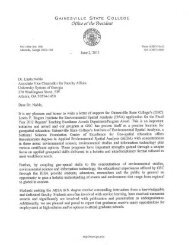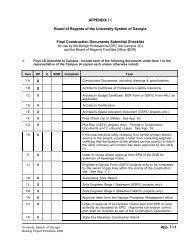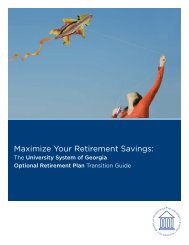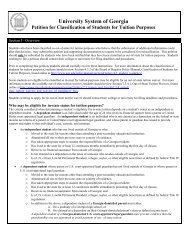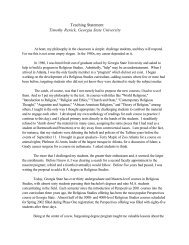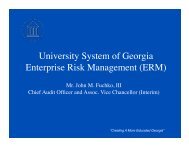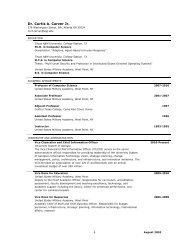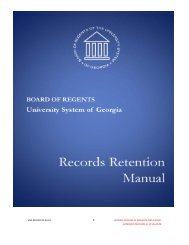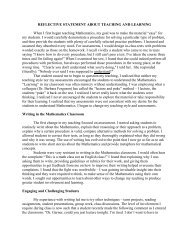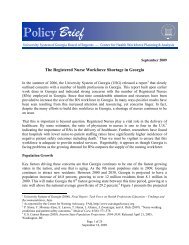WReier-Aviles on DSKGBLS3C1PROD with RULES266906 Federal Register / Vol. 75, No. 209 / Friday, October 29, 2010 / Rules and Regulationscommenters requested that there be nochange in this area or that FAAs bepermitted to make dependency statuschanges under certain circumstances,such as during verification, or at theirdiscretion. For example, one commentersuggested requiring the reporting <strong>of</strong> achange to dependency status until thefirst disbursement <strong>of</strong> title IV, HEA aidhas been made and that if thedependency status update results in achange in the applicant’s EFC, the lowervalue should be used. A couple <strong>of</strong>commenters observed that students whomarried late in the award year wouldbecome independent and need to havetheir aid repackaged for the award year.One commenter opposed all mid-yeardependency status changes because theyundermine the ‘‘snapshot’’ approach tothe application process and create alarge administrative burden. Anothercommenter noted the potential forstudents who divorced and becamedependent again to lose eligibility forthe aid they received because theirparents would refuse to provideinformation for the application. Stillanother remarked that it is hard forinstitutions to track dependency statusduring the award year because accuratetracking requires that students notify theinstitution <strong>of</strong> changes. One commenter,who stated that he appreciated thatwhen an update is due to a change inthe student’s marital status, institutionswould only be required to make theupdate if notified by the student, alsonoted that this approach can penalizethe student who is honest and reportsthe marital status change. Thiscommenter argued that such a change independency status should be reflectedin the application for the following year,as occurs under the current regulations.Another commenter suggested thatalthough the <strong>Department</strong> affirmed that itis not the institution’s responsibility toinitiate updating, this view ignores theburden imposed on institutions toresolve conflicts in information theyreceive from different sources. Thiscommenter requested relief forinstitutions so that they would onlyneed to make a dependency statuschange in ISIR information if thestudent or family was the source <strong>of</strong> theinformation supporting the dependencychange. Another commenter askedwhether institutions are required tokeep track <strong>of</strong> potential dependencystatus changes that are indicated byother campus <strong>of</strong>fices when the studentdoes not report the change. Onecommenter asked that there be a cut-<strong>of</strong>fdate after which an institution would nolonger be required to make dependencystatus changes. Another commenteragreed with the <strong>Department</strong>’s logic fornot having a cut-<strong>of</strong>f date, and asked thatinstitutions be permitted to set theirown date based on their academiccalendar.One commenter who supported midyeardependency status changesrequested that the <strong>Department</strong> allowupdates to household size and numberin college when there is a change inmarital status. Another commenterasked for early implementation <strong>of</strong>§ 668.55(c) because students areadversely affected by the currentregulations.Discussion: We agree that mid-yearverification updates to household sizeand number in college and dependencystatus updates would be burdensome toinstitutions if they resulted from achange in a student’s marital status.Accordingly, we have revised§ 668.55(a) to provide that if anapplicant’s dependency status changesat any time during the award year, theapplicant must update his or her FAFSAinformation, except when thedependency status change is due to achange in the applicant’s marital status.Also, to reduce burden to institutionswith regard to updating information, in§ 668.55(b)(2), we specify that anapplicant is not required to providedocumentation <strong>of</strong> household size,number in college, or the financial data<strong>of</strong> an applicant’s spouse during asubsequent verification <strong>of</strong> these dataitems if the information has notchanged. However, new paragraph (c) <strong>of</strong>this section would allow the institution,at its discretion, to require an applicantto update the applicant’s marital status,even if it results in a change in theapplicant’s dependency status, if theinstitution determines the update isnecessary to address an inequity or toreflect more accurately the applicant’sability to pay.In response to the comments aboutestablishing cut-<strong>of</strong>f dates for makingupdates, we note that under the revisedprovisions, an institution that decides tohave marital status updated pursuant to§ 668.55(c) may also incorporate in itspolicy a cut-<strong>of</strong>f date after which it willnot consider any updates to a student’smarital status.Changes: We have revised § 668.55(a)to provide that if any <strong>of</strong> the factors thatimpact an applicant’s dependencystatus changes at any time during theaward year, the applicant must updatehis or her FAFSA information, except ifthe item is the applicant’s marital status.Paragraph (b) <strong>of</strong> § 668.55 has beenrevised to provide that an applicant whois selected for verification <strong>of</strong> his or herhousehold size or number in collegemust update those items to be correct asVerDate Mar2010 14:10 Oct 28, 2010 Jkt 223001 PO 00000 Frm 00076 Fmt 4701 Sfmt 4700 E:\FR\FM\29OCR2.SGM 29OCR2<strong>of</strong> the date <strong>of</strong> verification, except whenthe update is due to a change in theapplicant’s marital status. As revised,§ 668.55(b)(2) also provides that anapplicant is not required to providedocumentation <strong>of</strong> household size ornumber in college during a subsequentverification for the same award year <strong>of</strong>either item if the information has notchanged. Finally, paragraph (c) <strong>of</strong>§ 668.55 provides that an institutionmay, at its discretion, update anapplicant’s marital status, even if theupdate will result in a change in theapplicant’s dependency status if theinstitution determines the update isnecessary to address an inequity or toreflect more accurately the applicant’sability to pay.Comment: One commenter askedwhether, when a student’s marital statusis updated, the student must have his orher spouse’s income reported to the CPSfor recalculation <strong>of</strong> the student’s EFC.Another commenter requested that the<strong>Department</strong> clarify how to treat incomein cases when the student marries ordivorces, regardless <strong>of</strong> whetherverification was performed. A thirdcommenter wondered why thehousehold size and number in collegeitems are updated while the income andassets items are not updated for newfamily members (e.g., the stepparent <strong>of</strong>a dependent student or the spouse <strong>of</strong> anindependent student).Discussion: As we stated earlier inthis preamble, we have revised § 668.55to provide that there is no updating <strong>of</strong>an applicant’s dependency status basedon a change in marital status except atthe discretion <strong>of</strong> an FAA. In such caseswhere an FAA chooses to update astudent’s dependency status as a result<strong>of</strong> a change in the student’s maritalstatus regardless <strong>of</strong> whether the studentis being verified, all <strong>of</strong> the informationmust be consistent with the change tothe marital status. This includes income(either adding the spouse’s income ordeducting a former spouse’s income) aswell as household size and number incollege. Note, however, that the revisedregulations do not allow for updatingwhen an otherwise independent studentmarries or divorces, i.e., there is nochange in dependency status and thestudent is not selected for verification.During verification, household sizeand number in college are updated, butthe income and assets <strong>of</strong> new familymembers are not typically includableitems on the FAFSA; for example, theincome or assets <strong>of</strong> a grandparent whocomes to live in the dependent student’sfamily would not be includable.Moreover, section 475(f)(3) <strong>of</strong> the HEAexcludes a stepparent’s income andassets from being reported on the
Federal Register / Vol. 75, No. 209 / Friday, October 29, 2010 / Rules and Regulations66907WReier-Aviles on DSKGBLS3C1PROD with RULES2FAFSA when a dependent student’sparent remarries after the FAFSA wassubmitted, though we have stated forseveral years in the Application andVerification Guide that an institutionmay use pr<strong>of</strong>essional judgment toinclude the stepparent’s financialinformation.Changes: As noted earlier in thisdiscussion, we have revised § 668.55 toprovide that applicants are not requiredto update their household size, numberin college, and dependency status whenthe update is needed as a result <strong>of</strong> achange in the student’s marital status,unless the institution chooses to updatethose items. When the institutiondetermines that updates are required asa result <strong>of</strong> a change in a student’smarital status, the student’s FAFSAinformation needs to reflect the accuratehousehold size, number in college,dependency status, and the spouse’sfinancial information.Comment: Some commentersquestioned whether, when completingthe FAFSA, students could project theirmarital status. One commenter arguedthat students should not be able toproject marital status as they projecthousehold size based on unbornchildren.Discussion: Because projected maritalstatus is prone to error, applicants maynot project their marital status whencompleting the FAFSA.Changes: None.Comment: A few commenters askedwhether the student or the institution isresponsible for updating informationthat impacts dependency status.Discussion: Students and institutionsboth are able to update information thatimpacts an applicant’s dependencystatus. Students can use FAFSACorrections on the Web (COTW) or apaper SAR to submit updates.Institutions can use FAA Access to CPSOnline or other <strong>Department</strong>al electronicprocesses to submit updates on thestudent’s behalf.Changes: None.Comment: One commenter asked usto clarify whether an institution mustprocess a change in dependency statusif a student is no longer enrolled at theinstitution.Discussion: An institution is notrequired to process a change in anapplicant’s dependency status if thestudent does not enroll or is no longerenrolled at the institution. However, ifthe student subsequently enrolls orreenrolls for the award year, requiredupdates must be made.Changes: None.Information To Be Verified (§ 668.56)Comment: Several commentersexpressed concern that even though thenumber <strong>of</strong> items to be verified under thenew targeted approach reflected in§ 668.56 will be reduced, the newapproach will not alleviate the burdenon the applicant or the institutionbecause the institution must stillidentify and resolve discrepancies in theinformation the institution receivesfrom different sources pursuant to§ 668.16(f). For example, if a studentwere selected to verify AGI or untaxedIRA income, and the documentation forthat is the tax return, the institution willneed to check the other data on the taxreturn to ensure there are no conflictswith what was reported on the FAFSA.One <strong>of</strong> these commenters stated that itwill continue to require full verification<strong>of</strong> all data items and to collect alldocumentation unless the applicantuses the IRS Data Retrieval Process.Another commenter suggested thatrelaxing the requirement to resolvediscrepancies in information under§ 668.16(f) would be a reasonablesolution if the <strong>Department</strong> is usinghistorical data that supports targetingspecific data elements.Discussion: Under § 668.16(f), aninstitution is required to resolvediscrepancies in the information itreceives from different sources withrespect to a student’s application forfinancial aid under the title IV, HEAprograms. Therefore, conflictinginformation between the FAFSAinformation and other information at theinstitution must be resolved, and theseregulations under subpart E do notchange this. We have no reason tobelieve that the new approach toselecting items for verification willincrease instances <strong>of</strong> conflictinginformation since any such conflictswould occur under the currentregulations where every applicantselected for verification must verifyinformation from a tax return.Changes: None.Comment: Some commentersdisagreed with the proposed targetedapproach to select items to be verifiedreflected in § 668.56 because theypredicted that it would add to theburden <strong>of</strong> institutions. One commenterstated that having verifiable itemsdifferent from the current five wouldrequire institutions to modify theirautomated correspondence and otherprocesses. This would result in the use<strong>of</strong> more paper at a time wheninstitutions are trying to reduce theircarbon footprint.Discussion: While a change in thenumber and type <strong>of</strong> verifiable items willVerDate Mar2010 14:10 Oct 28, 2010 Jkt 223001 PO 00000 Frm 00077 Fmt 4701 Sfmt 4700 E:\FR\FM\29OCR2.SGM 29OCR2require some work by financial aid<strong>of</strong>fices, we believe that there should notnecessarily be an increase in paper useand that once systems are automated,any additional administrative burdenshould be minimized. In fact, the use <strong>of</strong>the IRS Data Retrieval Process willreduce the amount <strong>of</strong> FAFSAinformation that institutions arerequired to verify and decrease thedocumentation an institution mustcollect and maintain. We believe thebenefits to institutions and to studentsas a result <strong>of</strong> this process justify anyextra work that institutions and studentswill experience in the short term.As explained earlier in this preamble,we are delaying the effective date for thechanges to subpart E <strong>of</strong> part 668 untilJuly 1, 2012, the 2012–13 award year.This will allow more time forinstitutions to prepare.Changes: None.Comment: Various commentersobserved that because the items forverification will be unpredictable,institutions will not be able to informapplicants and parents before receivingthe ISIR what documentation will berequired for verification. Commentersrequested that the <strong>Department</strong> providethe expected date for publishing the set<strong>of</strong> verifiable items in the FederalRegister in advance so that institutionshave time to implement any changes inthe items to be verified. Commentersrequested advance notice as late as mid-December to as early as 5 or 6 monthsprior to the beginning <strong>of</strong> the applicationcycle each January. Commenters statedthat institutions will have difficultiessetting up complicated systems andtraining aid administrators and otherstaff to comply with the changesreflected in the new approach toverification, especially given limitedresources on so many campuses. Onecommenter asked the <strong>Department</strong> to seta maximum number <strong>of</strong> items that can beselected for verification each year. Somecommenters suggested having multiyearsets <strong>of</strong> verification items, ratherthan different ones each year, toexpedite the verification process and toallow institutions time to plan. Onecommenter asked that each year the<strong>Department</strong> obtain public comment onthe selection criteria the <strong>Department</strong>will use to select items for verification.One commenter asked how institutionswould verify applicants’ FAFSAsconsistently for the overlap <strong>of</strong> twoprocessing years. Another commenterasked that the new regulations bedelayed until the IRS Data RetrievalProcess is fully implemented, whileanother commenter asked for a safeharbor period during crossover periodswhen institutions can use the old
- Page 1 and 2:
Friday,October 29, 2010Part IIDepar
- Page 3 and 4:
Federal Register / Vol. 75, No. 209
- Page 6 and 7:
66836 Federal Register / Vol. 75, N
- Page 8 and 9:
66838 Federal Register / Vol. 75, N
- Page 10 and 11:
WReier-Aviles on DSKGBLS3C1PROD wit
- Page 12 and 13:
66842 Federal Register / Vol. 75, N
- Page 14 and 15:
66844 Federal Register / Vol. 75, N
- Page 16 and 17:
WReier-Aviles on DSKGBLS3C1PROD wit
- Page 18 and 19:
66848 Federal Register / Vol. 75, N
- Page 20 and 21:
66850 Federal Register / Vol. 75, N
- Page 22 and 23:
WReier-Aviles on DSKGBLS3C1PROD wit
- Page 24 and 25:
66854 Federal Register / Vol. 75, N
- Page 26 and 27: WReier-Aviles on DSKGBLS3C1PROD wit
- Page 28 and 29: 66858 Federal Register / Vol. 75, N
- Page 30 and 31: 66860 Federal Register / Vol. 75, N
- Page 32 and 33: 66862 Federal Register / Vol. 75, N
- Page 34 and 35: 66864 Federal Register / Vol. 75, N
- Page 36 and 37: 66866 Federal Register / Vol. 75, N
- Page 38 and 39: WReier-Aviles on DSKGBLS3C1PROD wit
- Page 40 and 41: WReier-Aviles on DSKGBLS3C1PROD wit
- Page 42 and 43: 66872 Federal Register / Vol. 75, N
- Page 44 and 45: WReier-Aviles on DSKGBLS3C1PROD wit
- Page 46 and 47: WReier-Aviles on DSKGBLS3C1PROD wit
- Page 48 and 49: WReier-Aviles on DSKGBLS3C1PROD wit
- Page 50 and 51: 66880 Federal Register / Vol. 75, N
- Page 52 and 53: WReier-Aviles on DSKGBLS3C1PROD wit
- Page 54 and 55: 66884 Federal Register / Vol. 75, N
- Page 56 and 57: 66886 Federal Register / Vol. 75, N
- Page 58 and 59: WReier-Aviles on DSKGBLS3C1PROD wit
- Page 60 and 61: WReier-Aviles on DSKGBLS3C1PROD wit
- Page 62 and 63: WReier-Aviles on DSKGBLS3C1PROD wit
- Page 64 and 65: WReier-Aviles on DSKGBLS3C1PROD wit
- Page 66 and 67: WReier-Aviles on DSKGBLS3C1PROD wit
- Page 68 and 69: WReier-Aviles on DSKGBLS3C1PROD wit
- Page 70 and 71: WReier-Aviles on DSKGBLS3C1PROD wit
- Page 72 and 73: 66902 Federal Register / Vol. 75, N
- Page 74 and 75: WReier-Aviles on DSKGBLS3C1PROD wit
- Page 78 and 79: 66908 Federal Register / Vol. 75, N
- Page 80 and 81: WReier-Aviles on DSKGBLS3C1PROD wit
- Page 82 and 83: 66912 Federal Register / Vol. 75, N
- Page 84 and 85: WReier-Aviles on DSKGBLS3C1PROD wit
- Page 86 and 87: 66916 Federal Register / Vol. 75, N
- Page 88 and 89: WReier-Aviles on DSKGBLS3C1PROD wit
- Page 90 and 91: WReier-Aviles on DSKGBLS3C1PROD wit
- Page 92 and 93: WReier-Aviles on DSKGBLS3C1PROD wit
- Page 94 and 95: 66924 Federal Register / Vol. 75, N
- Page 96 and 97: WReier-Aviles on DSKGBLS3C1PROD wit
- Page 98 and 99: 66928 Federal Register / Vol. 75, N
- Page 100 and 101: WReier-Aviles on DSKGBLS3C1PROD wit
- Page 102 and 103: 66932 Federal Register / Vol. 75, N
- Page 104 and 105: WReier-Aviles on DSKGBLS3C1PROD wit
- Page 106 and 107: 66936 Federal Register / Vol. 75, N
- Page 108 and 109: 66938 Federal Register / Vol. 75, N
- Page 110 and 111: 66940 Federal Register / Vol. 75, N
- Page 112 and 113: 66942 Federal Register / Vol. 75, N
- Page 114 and 115: 66944 Federal Register / Vol. 75, N
- Page 116 and 117: 66946 Federal Register / Vol. 75, N
- Page 118 and 119: WReier-Aviles on DSKGBLS3C1PROD wit
- Page 120 and 121: WReier-Aviles on DSKGBLS3C1PROD wit
- Page 122 and 123: WReier-Aviles on DSKGBLS3C1PROD wit
- Page 124 and 125: 66954 Federal Register / Vol. 75, N
- Page 126 and 127:
WReier-Aviles on DSKGBLS3C1PROD wit
- Page 128 and 129:
66958 Federal Register / Vol. 75, N
- Page 130 and 131:
66960 Federal Register / Vol. 75, N
- Page 132 and 133:
WReier-Aviles on DSKGBLS3C1PROD wit
- Page 134 and 135:
WReier-Aviles on DSKGBLS3C1PROD wit
- Page 136 and 137:
WReier-Aviles on DSKGBLS3C1PROD wit
- Page 138 and 139:
66968 Federal Register / Vol. 75, N
- Page 140 and 141:
66970 Federal Register / Vol. 75, N
- Page 142 and 143:
66972 Federal Register / Vol. 75, N
- Page 144 and 145:
66974 Federal Register / Vol. 75, N



